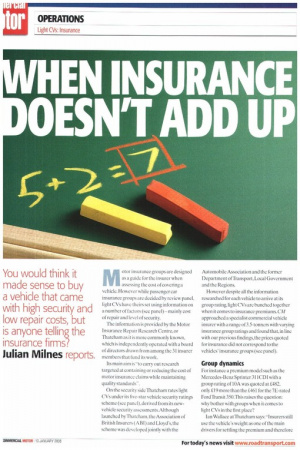You would think it
Page 38

Page 39

If you've noticed an error in this article please click here to report it so we can fix it.
made sense to buy a vehicle that came with high security and low repair costs, but is anyone telling the insurance firms?
Julian Milnes reports. Motor insurance groups are designed as a guide for the insurer when assessing the cost of covering a vehicle. However while passenger car insurance groups are decided by review panel, light CVs have theirs set using information on a number of factors (see panel) — mainly cost of repair and level of security.
The information is provided by the Motor Insurance Repair Research Centre, or Thatcham as it is more commonly known, which is independently operated with a hoard of directors drawn from among the 31 insurer members that fund its work.
Its main aim is"to carry out research targeted at containing or reducing the cost of motor insurance claims while maintaining quality standards'..
On the security side Thatcham rates light CVs under its five-star vehicle security ratings scheme (see panel). derived from its newvehicle security assessments. Although launched by Thatcham, the Association of British Insurers (ART) and Lloyd's, the scheme was developed jointly with the Automobile Association and the former Department of Transport, Local Government and the Regions.
However despite all the information researched for each vehicle to arrive at its group rating. light CVs are bunched together when it comes to insurance premiums. CM approached a specialist commercial vehicle insurer with a range of 3.5-ionners with varying insurance group ratings and found that,in line with our previous findings, the prices quoted for insurance did not correspond to the vehicles' insurance groups (see panel).
Group dynamics For instance a premium model such as the Mercedes-Benz Sprinter 311CDI with a group rating of 10A was quoted at £482, only £19 more than the £461 for the 7E-rated Ford Transit 350.This raises the question: why bother with groups when it comes to light CVs in the first place?
Ian Wallace at Thatcham says:Insurers still use the vehicle's weight as one of the main drivers for settling the premium and therefore the differentials are what we would expect for vans of the same weight... when a van is first launched the insurers will not have any claims experience." This makes van selection a slightly less strategic decision.
Wallace adds that once the insurer has gained its own experience it will adjust the premium accordingly and therefore the premium will differ from one insurer to the next.
But it is not as if manufacturers aren't going out of their way to help with lowering groups through developments in safety and security.
Ford says its product engineering team sets itself targets in the different areas that affect the cost of insurance, including crash repairability costs, parts prices, the cost of replacing parts, and security and theft issues, pointing to the fact that in the UK it consults Thatcham on the security aspects of insurance.
However a single issue can increase the cost of insurance. Malcolm Tarling at the ABI says: "A simple thing such as replacing the injection pump may be a complex task when being repaired in a certain vehicle and this can contribute to the overall cost of insurance." •


































































































































































